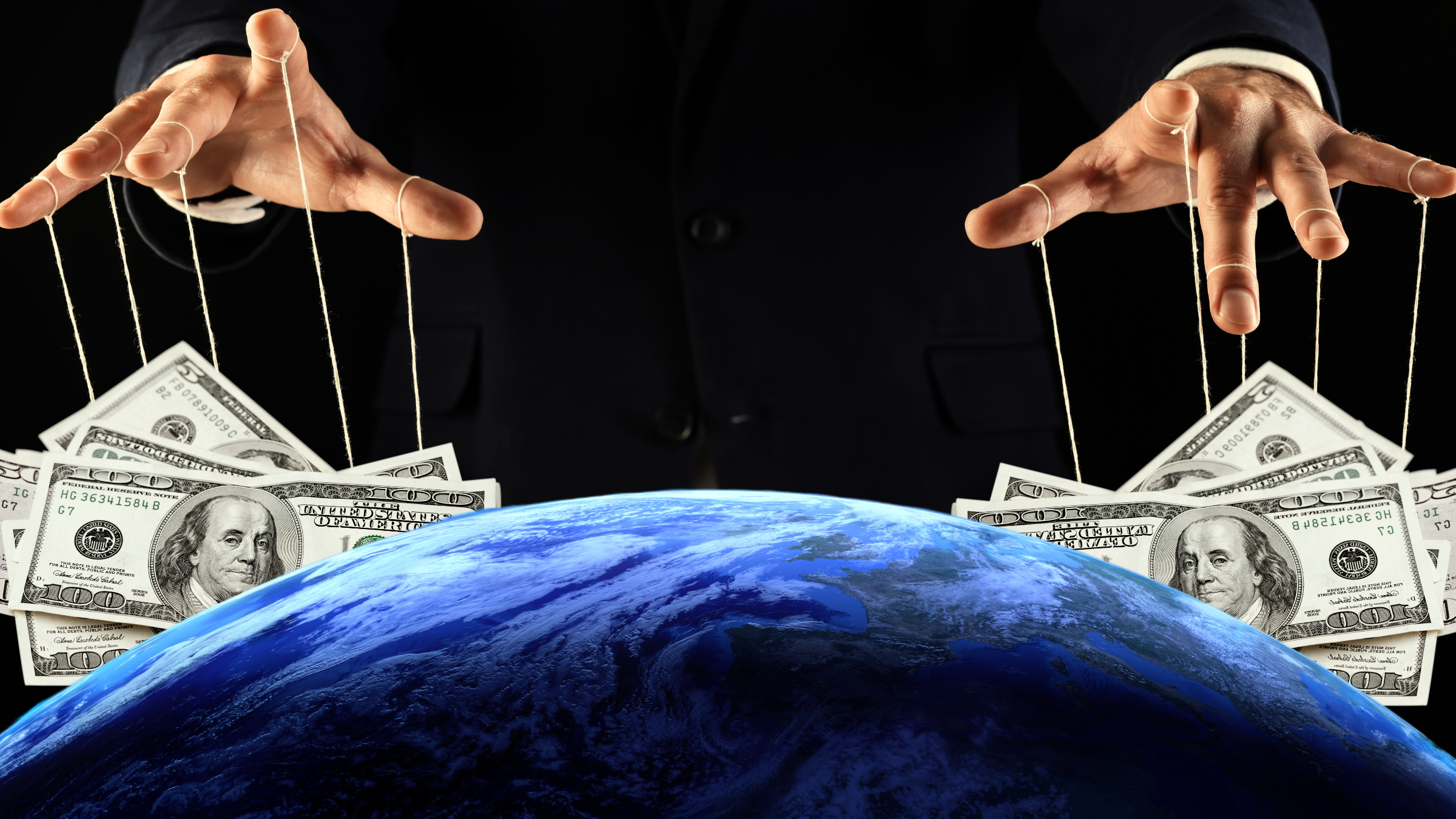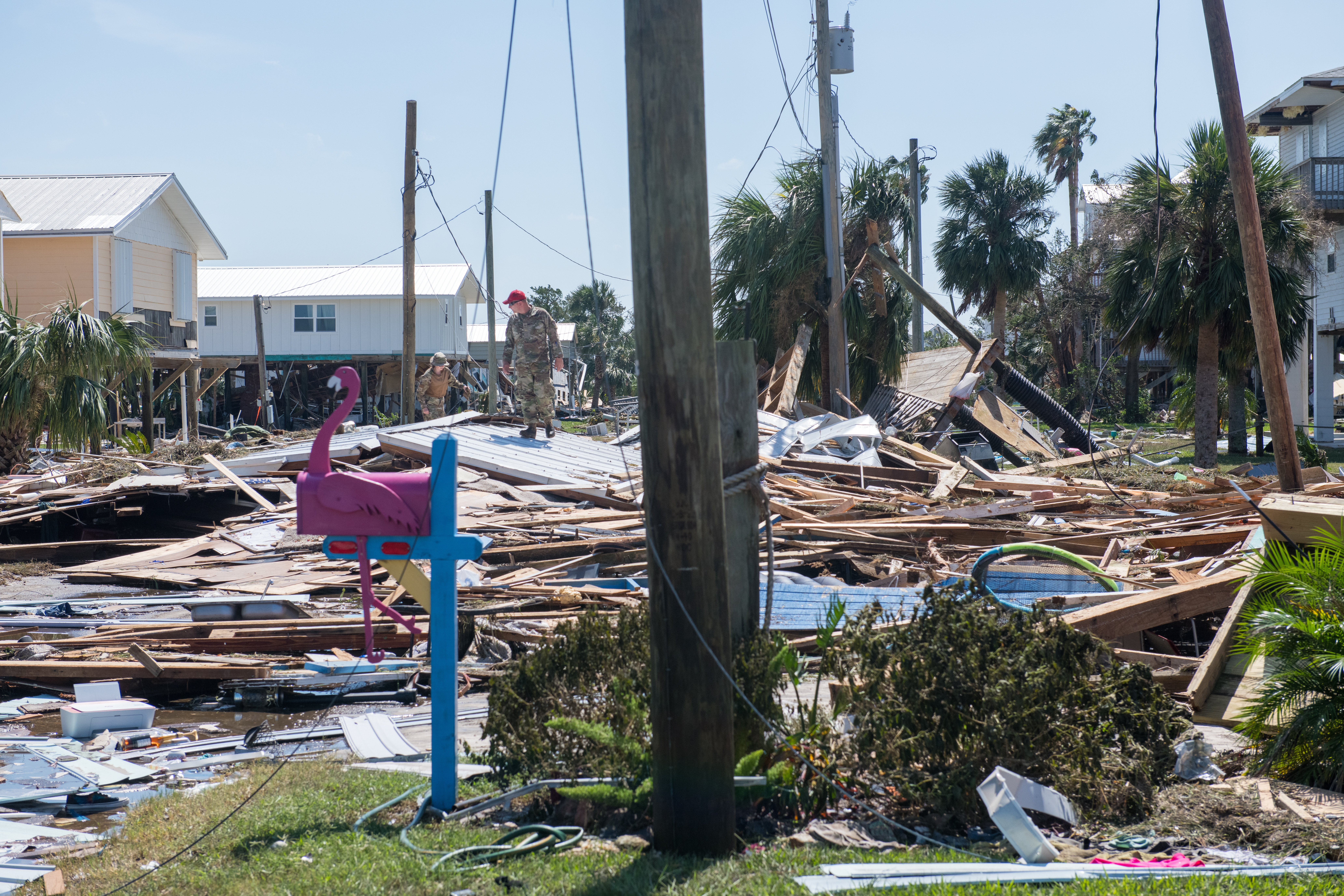Will the Steady State Economy Be Funded?

Wealthy funders pull the world’s economic and environmental strings (image created by author using Canva content).
by Kali Young
The U.S. nonprofit sector is a $1.4 trillion industry. If it were a country, it would be one of the world’s largest economies. Wealthy individual donors, foundations, and corporations are the three largest sources of nonprofit funding. As such, these entities have tremendous influence over what kind of social, economic, and political change thrives or dies. Many large foundations and major donors have amassed wealth thanks to the very economic system that is pushing the world toward ecological collapse.
Corporations often donate to foundations to write off windfall profits for tax purposes, sometimes in dubious ways. These include fake asset donations, individual and family tax shelters, corporate pass throughs and funding loops, and relatively unregulated and unspent Donor Advised Funds. A significant portion of donated funds never benefit the public. What’s more, funders often grow their endowments and reserves from harmful investments that undermine their mission.
According to Commonfund, only 23 percent of foundations use environmental, social, and governance (ESG) or similar criteria for investment screening. Another study found that a mere five percent of foundations proactively use their investments for positive social and environmental impact. Conventional investment portfolios contribute to societal ills, such as fossil-fuel use, deforestation, the prison industrial complex, and weapons manufacturing. In a Bellagio Forum survey, 67 percent of foundations said it was important to invest in the clean energy transition. However, only 25 percent have asked their fund managers to use climate as a selection criterion.
Funding Economic Systems Change: A Conflict of Interest
The fact that foundations receive income from harmful investments puts them on the horns of a dilemma. How much impact can they have—how much economic systems change can they fund—without affecting their income? In a nonprofit blog article about this conundrum, Vu writes, “We allow inequitable systems to go unchallenged. By reinforcing donors’ and foundations’ harmful behaviors and then allowing them to charity-wash the harm they might cause, we give the illusion that progress is being made, which increases complacency and reduces the urgency to actually solve systemic problems.”

There is a growing sentiment that there’s something fundamentally wrong with our economic system (Chris Yakimov, Flickr).
Will foundations step up and fund necessary change, even if it undermines their income sources in the short term? Will they go all in to stop ecological collapse? Will they support the movement for developed nations’ degrowth toward a steady state economy?
Thus far, few funders have stepped up to bat. Over the last five years, I’ve scoured thousands of records in the most comprehensive foundation databases. I’ve discovered that funding options for economic transformation are shockingly scarce. As an issue category, economics does not rank at all on most industry-wide philanthropic giving reports. When foundations do fund economics initiatives, they generally support projects within the neoliberal economic status quo. Economic systems transformation programs remain marginalized and underfunded.

It’s not enough to bandage the downstream symptoms. We must treat social and ecological crises upstream (Luc Lavoie, Wikimedia Commons).
One could argue that funders mitigate downstream consequences, or “externalities,” of harmful economic policies and private sector economic growth. That’s only somewhat true. Wealth and income inequality have risen sharply over the last decade. Housing and social services aren’t keeping up with the growing population of U.S. working poor and their struggles. Without serious economic reforms, these issues will continue to spiral out of control.
Environmental Funding and the Oxymoron of Green Growth
Environmental work, though better-resourced than economic systems change, is also funded at an abysmal rate. It receives about one-seventh the funding that religion receives. According to Carbon Switch, “Environmental nonprofits receive less than two percent of charitable dollars. Of the $471 billion that donors gave to nonprofits in 2020, only $8 billion went to environmental nonprofits.” Most major philanthropic reports reveal that the environment receives the smallest piece of the funding pie of all listed issue categories (economy is rarely listed).
As climate change has taken center stage in recent years, the percentage of charitable dollars that goes to the environment has increased slightly, by one percent. Contributing to that bump, the Rockefeller Foundation recently committed $1 billion to climate solutions through its Big Bets program. Though climate philanthropic funding is growing, its growth rate has slowed since 2022. Additionally, private sector climate investments were down 40 – 50 percent in 2023. The climate funding gap is estimated to be around $6 trillion per year globally.
Within the categories of environmental and economic development funding, many nonprofit and for-profit funders are backing green growth projects. Green growth aims to “decouple” economic growth from environmental impact by prioritizing sustainability, resource efficiency, and clean technologies. Humanity will likely look back on green growth (as opposed to degrowth to a steady state economy) as a tragic detour from actual solutions.

We’re running out of time to right our economic wrongs (Adobe Stock).
There is a growing, though not widely-publicized, body of reputable evidence that the green growth strategy is not effective against ecological collapse. However, the green growth narrative offers the convenient feeling of a win-win without sacrifice. Many who have benefited from the current system—including wealthy donors and corporations—prefer this narrative. The less palatable, inconvenient truth is that more drastic, fundamental change is needed.
A recent article in Harvard Business Review, “In Defense of Degrowth,” sounds the alarm on the green growth myth: “The core of the degrowth argument is the historical fact that economic growth and emissions are inexorably connected. Trends in the contemporary business community that fundamentally discount this relationship, like ‘green growth,’ ‘green innovation,’ and the coming ‘energy transition,’ promote an illusory goal of unfettered growth and sustainability.”
Growth and Climate Collide
It may be tempting for funders to cling to reports that wealthier European nations have achieved some decoupling of domestic greenhouse gas emissions from economic growth. However, wealthy countries often outsource environmentally-destructive production of goods consumed within their borders, which skews reporting metrics. What’s more, the “green transition” undergone by these countries requires a level of financial, natural, and political resources not available to most countries. Decoupling appears to be a false hope for the world as a whole.
Many funders have channeled their environmental benevolence into the renewables transition, but it’s not enough. Renewable energy is addressing increased demand, not replacing fossil fuels. In absolute terms, fossil-fuel use is still growing. Even if it received the necessary funding, the renewables transition is not a decoupling holy grail. It requires mining scarce minerals and using (mostly fossil-fuel) energy for manufacturing.
Alternative, “sustainable” products may also be an enticing target for funders and investors. Yet, even with green alternatives now widely available, 45 percent of global greenhouse gas emissions come from production of the goods we consume. Many companies that sell “green” products offer minimal ecological footprint reduction. Some intentionally greenwash their brands, with no footprint reduction at all. Carbon offset scams are an infamous example of such greenwashing.
Unfortunately, funders may not be able to have their cake and eat it too. After studying 34,000 papers on climate, Lisa Schipper (environmental research fellow at Oxford and the IPCC) concluded that limiting economic growth seems unavoidable. “Degrowth has reemerged over the last few years out of a frustration with other kinds of economic models.” Jason Hickel, a global leading researcher in climate economics, summarizes his research on green growth and climate:
“…Empirical evidence on resource use and carbon emissions does not support green growth theory. Examining relevant studies on historical trends and model-based projections, we find that: (1) there is no empirical evidence that absolute decoupling from resource use can be achieved on a global scale against a background of continued economic growth, and (2) absolute decoupling from carbon emissions is highly unlikely to be achieved at a rate rapid enough to prevent global warming over 1.5°C or 2°C, even under optimistic policy conditions. We conclude that green growth is likely to be a misguided objective, and that policymakers need to look toward alternative strategies.”
On our finite planet, the end of economic growth is indeed inevitable. To what extent will we let our global ecosystem collapse in the meantime? A steady-state or degrowth economic strategy may significantly improve the odds of stopping climate change, due to decreased energy demands. Just like any new strategy, this will require funding to incubate and implement.
The Federal Funding Cliff
The United States saw a massive increase in federal funding for environmental work under the Biden administration. Hundreds of billions of dollars went into an ambitious fleet of programs: the Inflation Reduction Act (IRA), the Justice 40 Initiative, the Climate Corps, the Home Efficiency Rebates Program, the Green House Gas Reduction Fund, the Clean Ports Program, the Climate Pollution Reduction Program, the USDA Climate Mitigation Grants, and many more.
These initiatives aim to provide living-wage jobs for marginalized and former coal communities, reduce pollution in highly-impacted areas, restore ecosystems, and close in on net zero greenhouse gas emissions. Though they don’t provide the economic transformation that will ultimately be necessary, these programs have bought us climate time. Projects like Reimagine Appalachia, funded by the IRA, have midwifed coal and natural gas communities into the future with sustainability initiatives and jobs in the renewables sector.
Over the course of one day, November 5th, the future of all that federal climate and environmental funding went up in smoke. Trump has vowed to do away with the Environmental Protection Agency and climate funding and increase fossil fuel extraction in the United States. Without government resources for environmental initiatives, and as the incoming administration will prioritize growth at any cost, steady statesmanship will be all the more critical.

Damage in Keaton Beach, Florida, from Hurricane Helene (Jacob Hancock, Wikimedia Commons).
Though Trump won’t admit it, environmental degradation, and especially climate change, is bad for business in the long term. It destabilizes the economy, increasing costs and damaging infrastructure. Predictions put the cost of global climate change damages at $38 trillion per year by 2050. In 2022, climate-related economic losses totaled approximately $300 billion. These losses are primarily due to lower human productivity ($2.4 trillion by 2030), damage to infrastructure, reduced agricultural output, sea-level rise, and energy volatility. Yet the compounding, cumulative effects of climate change are beyond what we can reasonably predict.
Funding Solutions to the Root Problem
Economic growth, whether it’s “green” or not, is a net loss for the environment and the economy in the long term. It’s time to take a big-picture, long-term view for future generations. Donors may have historically benefited from the growth economy. However, as we hurdle past planetary boundaries, the environmental consequences of this system will eventually cause severe economic malfunctions. We are rapidly approaching a point where we will no longer have a choice between growth and a steady state.
As federal funding takes a big dip for the next four years, we have to be strategic. The world needs funding for both environmental protection and economic systems change, even if it threatens funders’ sources of income. Otherwise, the damage caused by economic growth will erase many of the temporary gains made by downstream mitigation. Funders must start to support upstream economic systems change, and fast.
Kali Young is a development manager at CASSE.







It is about time the guardians of health recognized that the three major contributors to obesity, ill-health and scattered thinking are meat,dairy and sugar. It just so happens that the production of these products also have major damaging effects on our environment. We are feeding our medical industry with profit motivated foods that incapacitate our ability to think and act. Who questions a Big Mac, french fries and a milkshake – especially if its a ‘bargain’.
Thanks for the great article, Kali.
For non-Americans, the USA is an intriguing country. Philanthropy (or charity-washing as you so rightly put it) is ‘big business’ in the US. It is much bigger than in Australia (where I live), largely because the US doesn’t have a welfare safety net like we have in Australia (although it’s not what it used to be, thanks to neoliberalism). Also, governments play a more active role in the economy in Australia, although, again, not to the extent that they once did. Still, a more active role of governments means less need for charity.
Governments will need to play a key role in any transition to a steady-state economy. One of the most important will be ‘capping’ the rate of throughput (the rate of resource extraction and waste generation) to ensure it remains within the ecosphere’s regenerative and waste assimilative capacities. That won’t require much in the need for funding, since it is a human management issue, not a technological issue.
However, you are right that we need ‘green’ investments – investment in (replenishing) natural capital, renewable energy and low-carbon technologies, recycling, etc. – to make the best of a steady-state economic world. Many of these things have public goods characteristics, which means they are not profitable for the private sector to provide. There will be a big reliance on governments, especially those with currency-issuing powers (e.g., the US Federal Government), to step up to the funding plate, although that’s not likely to happen in the US over the next four years. Nor with a “drill, baby, drill” attitude is there much likelihood of caps being imposed on the rate of throughput.
Whoever takes over in four years’ time will have to deal with the mess that Trump leaves behind. A lot of attention will need to focus on convincing Trump’s likely successor of the need for a steady-state economy (as well as Americans generally) by explaining the root cause of the mess he’s about to make.
Hi Philip! You are correct that in the US, the nonprofit and philanthropic sector (as well as business) uniquely stands in for many roles and functions of government. Our federal government is more hands off than in many wealthy nations — healthcare being a stark example. This is very unfortunate given we need to be aggressively planning to degrow the economy in a functional, fair and just way; to coordinate redesigning much of the existing economic infrastructure to be more efficient and renewable; and to reallocate resources for the cause, across the country, as well as working diplomatically with other countries, to prevent ecological collapse and the ensuing social consequences. In the US at least, philanthropy, nonprofits, businesses that are willing, and the more progressive US states will need step up to the challenge of government-like collaboration and coordination. The task is made all the more difficult as we will be trying to make up for a President who has been both antagonistic towards the environmental cause and extremely progrowth, whereas our last President was moderately progrowth but also moderately pro-environment. More global and local work, including US state level, becomes absolutely crucial.
Thank you for this astute, well-reasoned and profoundly important essay. I will be sharing it widely, and hope others do as well…